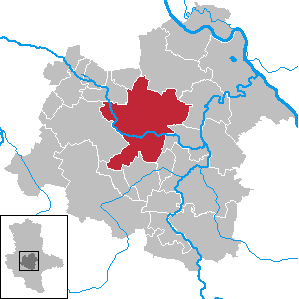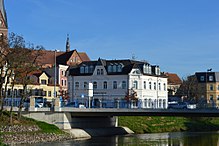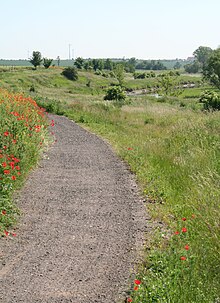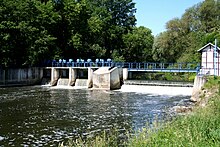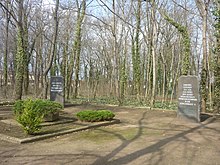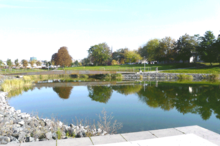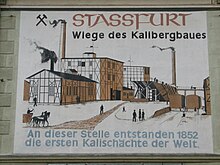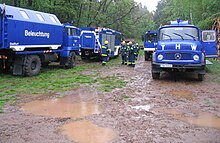Staßfurt
| coat of arms | Germany map | |
|---|---|---|

|
Coordinates: 51 ° 51 ' N , 11 ° 35' E |
|
| Basic data | ||
| State : | Saxony-Anhalt | |
| County : | Salzlandkreis | |
| Height : | 73 m above sea level NHN | |
| Area : | 146.71 km 2 | |
| Residents: | 24,923 (Dec. 31, 2019) | |
| Population density : | 170 inhabitants per km 2 | |
| Postcodes : | 39418, 39443, 39446 | |
| Primaries : | 03925, 039265 , 039266 , 039262 | |
| License plate : | SLK, ASL, BBG, SBK, SFT | |
| Community key : | 15 0 89 310 | |
| City structure: | Central place and 4 localities | |
City administration address : |
Hohenerxlebener Strasse 12 39418 Staßfurt |
|
| Website : | ||
| Lord Mayor : | Sven Wagner ( SPD ) | |
| Location of the city of Staßfurt in the Salzlandkreis | ||
Staßfurt is a town in the Salzlandkreis in Saxony-Anhalt . Staßfurt became the birthplace and cradle of global potash mining on January 31, 1851 . The former Royal Prussian salt mine with the two shafts von der Heydt and von Manteuffel was the first potash mine in the world.
geography
Geographical location
Staßfurt is located on the southern edge of the Magdeburg Börde , south of the state capital Magdeburg . The city is crossed by the Bode .
Neighboring communities
|
10 km |
10 km |
15 km |
|
4 km |

|
15 km |
|
11 km |
10 km |
10 km
|
City structure
Staßfurt is divided into the following districts and city districts (with postcodes):
-
 Altstaßfurt (39418)
Altstaßfurt (39418) -
 Staßfurt (old town) (39418)
Staßfurt (old town) (39418) -
 Staßfurt-North (39418)
Staßfurt-North (39418) -
 Leopoldshall (39418)
Leopoldshall (39418) -
 Athens life (39446)
Athens life (39446) -
 Atzendorf (39443)
Atzendorf (39443) -
 Brumby (39443)
Brumby (39443) -
 Förderstedt (39443)
Förderstedt (39443) -
 Glöthe (39443)
Glöthe (39443) -
 Hohenerxleben (39443)
Hohenerxleben (39443) -
 Löbnitz (39443)
Löbnitz (39443) -
 Löderburg (39446)
Löderburg (39446) -
 Lust (39446)
Lust (39446) -
 New Staßfurt (39418)
New Staßfurt (39418) -
 Neundorf (39418)
Neundorf (39418) -
 Rathmannsdorf (39418)
Rathmannsdorf (39418) -
 Rothenförde (39446)
Rothenförde (39446) -
 Üllnitz (39443)
Üllnitz (39443)
climate
Staßfurt has a temperate climate all year round with cold winters, warm summers and mild menopause.
|
Monthly climate averages in Staßfurt
Source: www.urlaubplanen.org/stassfurt
|
|||||||||||||||||||||||||||||||||||||||||||||||||||||||||||||||||||||||||||||||||||||||||||||||||||||||||
history
In the year 806 the first (secured) document mention of Staßfurt (in the early Middle Ages the village of Alt-Staßfurt was only called Staßfurt) took place in connection with an invitation by Emperor Charlemagne to the abbot Fulrad of St. Quentin to hold an army meeting in Starasfurt on the Bode . The interpretation of the name is based on a combination of the Old Slavic word for old (staraja) with the Old High German word Furt (crossing point). The importance of Staßfurt in the Middle Ages was due to its location on this ford through the Bode. The old trade and salt route from Lüneburg to Halle / Saale ran along here. The village of Alt-Staßfurt north of the Bode was securely and spiritually subordinate to the ore monastery of Magdeburg . In the 11th century the castle (fortification) was built south of the Bode. As early as 1180, the Staßfurt settlement area south of the Bode within the defensive walls was granted city rights. The city of Staßfurt was secularly owned by the Counts of Anhalt until 1277 . The descendants of Albrecht the Bear and Dukes of Saxony, Johann I and Albrecht II, had invested so much effort in celebrating their accolade that on July 8, 1276, they also turned over the city of Staßfurt, which they owned, to settle their debts had to pledge Archbishop Konrad II of Magdeburg. Since the dukes could not pay the high debt of 6,000 silver marks within a year, Staßfurt fell to the ore monastery of Magdeburg from 1277 onwards. As a so-called Immediatstadt , Staßfurt was directly subordinate to the Brandenburg-Prussian Duchy of Magdeburg from 1680 and was in the Holzkreis until 1807 . From 1815, Alt-Staßfurt and the city of Staßfurt in the administrative district of Magdeburg belonged to the province of Saxony and remained on Prussian territory until the dissolution of the Prussian state in 1947.
During the Second World War , the subcamp of the Buchenwald Staßfurt I / Neustaßfurt concentration camp (code name "Reh") was built on September 13, 1944 between Löderburg-Lust and Atzendorf , in which 459 prisoners, mostly from France , took part in the underground relocation of Ernst Heinkel AG together with Polish concentration camp prisoners had to work under extremely poor conditions, with between 300 and 380 losing their lives. Another subcamp existed in Leopoldshall from December 28, 1944. Both camps were evacuated on April 11, 1945 with a death march . The Little Boy atomic bomb, which exploded over Hiroshima on August 6, contained 64 kilograms of uranium. At least part of the uranium allegedly came from the approximately 1,100 tons of uranium ore and uranium oxide that the Americans had seized in Staßfurt in the second half of April 1945.
From 1952 to 1994 Staßfurt was the district town of the Staßfurt district in the GDR district and later the administrative district of Magdeburg . With the district reform in 1994, the new Aschersleben-Staßfurt district with the new district town of Aschersleben was formed by merging the Aschersleben and Staßfurt districts . In the course of the district reform in 2007, Staßfurt moved to the newly formed Salzlandkreis .
The SWAPO sent during the independence struggles in South West Africa in the 1980s children to education and training in the GDR . At the beginning of 1990 there were 291 such children at the School of Friendship in Staßfurt. They were brought back in August 1990 - together with 134 small children from Bellin - to the now independent and SWAPO-ruled Namibia .
During the GDR era, the two prefabricated housing estates “Leninring” (today “Nord”) and “Am Tierpark” were built, while the building fabric of the inner city - provided it did not have to be demolished due to mountain damage - increasingly fell into disrepair. Only the urban redevelopment carried out since 1991 led to a trend reversal.
Population development
(from 1955 on December 31, from 2007 including the districts)
|
|
|
|
|
|
Incorporations
The village of Altstaßfurt on the left (northern) bank of the Bode is older than the city of Staßfurt on the right bank of the Bode and was incorporated into the city of Staßfurt on December 12, 1868.
In 1946, the neighboring town of Leopoldshall in Anhalt , which was established in 1873 in the area of the municipality of Neundorf (Anhalt) , was forcibly incorporated into Staßfurt . The 1873 anhaltischem place founded directly Staßfurt area had since January 29, 1919 city charter held.
In 2003 the places Löderburg (with the districts Rothenförde, Lust and Athensleben as localities) and Hohenerxleben were incorporated. Rathmannsdorf followed at the beginning of 2004. On January 1, 2009 the communities Neundorf (Anhalt) and Förderstedt were added.
| Former parish | date | Remarks |
|---|---|---|
| Altstaßfurt | December 12, 1868 | Incorporation into the city of Staßfurt |
| Athens life | July 1, 1950 | Incorporation to Löderburg |
| Atzendorf | March 10, 2004 | Incorporation to Förderstedt |
| Brumby | May 18, 2006 | Incorporation to Förderstedt |
| Förderstedt | January 1, 2009 | |
| Glow | May 18, 2006 | Incorporation to Förderstedt |
| Hohenerxleben | March 1, 2003 | |
| Leopoldshall | 1873 April 1, 1946 |
Outsourcing from Neundorf (Anhalt), incorporation to Staßfurt |
| Löbnitz (Bode) | January 29, 2004 | Incorporation to Förderstedt |
| Löderburg | March 1, 2003 | Neu Staßfurt district incorporated into Staßfurt as early as 1969 |
| Neundorf (Anhalt) | January 1, 2009 | |
| Rathmannsdorf | January 1, 2004 | |
| Üllnitz | July 1, 1950 | Incorporation after Glöthe |
politics
City council
The city council has 36 seats and has been composed as follows since the local elections on May 26, 2019 :
- CDU : 9 seats
- Left : 7 seats
- SPD : 5 seats
- FDP : 4 seats
- Greens : 1 seat
- AfD : 7 seats
- Independent citizens' council Staßfurt (UBvS): 2 seats
- Independent community of voters (UWG) Salzland: 1 seat
mayor
- 1929–1933: Hermann Kasten (SPD)
- 1990–1994: Eckhard Metz (CDU)
- 1994-2008: Martin Kriesel (CDU)
- 2008–2015: René Zok (independent)
- since July 7, 2015: Sven Wagner (SPD)
coat of arms
Blazon : "In the shield divided by red and silver, St. John the Baptist in a golden robe, pointing with his right to the lamb of God carried on his left arm with the flag of the cross."
The city colors are red and white, the colors of the Archdiocese of Magdeburg . These basic colors were also retained when a new coat of arms was introduced on June 21, 1960 during the time of the GDR. This was "square of 1: 4 red and 2: 3 silver, inside a combined blue wheel, above the division as a pulley with a conveyor rope running diagonally downwards to the edge of the shield, below designed as a gear wheel, covered with an upright golden ear, this in turn with a silver retort ”. This was to symbolize the city's most important economic sectors. With the end of the GDR, the city council decided on June 1, 1990 to return to the old coat of arms. However, this was not confirmed by the Ministry of the Interior of the State of Saxony-Anhalt in 1994, as it was seen as a violation of the principles of heraldry. Thereupon the towers (battlements) were dispensed with and the color of the robe was changed from red to gold. This new coat of arms was approved by the city council on March 19, 1995 and subsequently confirmed by the Ministry of the Interior.
Town twinning
On October 25, 1989, Lehrte and Staßfurt signed the town twinning agreement. Occasional visits by both (lord) mayors are still taking place. But there is no fixed date.
Culture, sights, churches
Memorials
- Monument from 1966 in the cemetery forecourt of the Löderburg district in memory of the victims of forced labor , in German and French, renewed in 1992
- Memorial stone on Luisen-Platz (Ernst-Thälmann-Platz in GDR times) in memory of the KPD chairman, who was murdered in Buchenwald concentration camp in 1944 , and all victims of fascism
- Memorial plaque on his house in Hermann-Kasten-Straße to the mayor Hermann Kasten , who was murdered there in 1933. Memorial stones were also placed for him at elementary and secondary schools with his name
theatre
The Salzlandtheater is a guest theater with a hall for up to 310 people, houses a gallery and the smaller Tilly hall (actually in the city palace of Werdensleben ).
The most famous amateur drama ensemble from Staßfurt is the student theater of the Dr.-Frank-Gymnasium .
Churches
- Evangelical Church of St. Petri, Königsplatz
- Evangelical Church St. Johannis , Leopoldshall / Staßfurt, Kirchplatz
- Catholic Church of St. Marien, Bergstrasse
music
Numerous musical formations exist in Staßfurt. Some are mentioned here:
orchestra
- Student accordion orchestra of the Béla Bartók District Music School (since 1956)
- Youth Brass Orchestra Staßfurt (since 1961)
- Accordion Orchestra "Salzland" e. V. (since 1996)
Choirs
- Men's Choir of the Staßfurt Crafts (since 1945)
- Salzland Women's Choir Staßfurt (since 1991)
Museums
The City and Mining Museum of the City of Staßfurt is located in one of the oldest houses in the city from the 17th century.
The radio museum of the Staßfurter Rundfunk- und Fernsehtechnik eV association is located in the former administration building of the television equipment factory (RFT). V.
The vehicle museum in Staßfurt on Berlepschstrasse tells the history of vehicles in the East.
Buildings
Noteworthy and important buildings within Staßfurt are above all:
- the medieval city wall with front wall and kennel, as well as several towers and a particularly well-preserved roundabout
- the Werdenslebensche From house with Tilly Hall (formerly. Bürgermeisterhaus / Theater Café)
- the medieval city bailiwick (former Adler pharmacy)
- The Staßfurt depot on the Schönebeck – Güsten railway line went into operation in 1856 . The over 100 year old circular shed can accommodate 24 locomotives . The associated turntable measures 20 m in diameter. Class 41 and 50 steam locomotives were used as planned until 1988. Passenger, express and freight trains were hauled. Through the association Eisenbahnfreunde Traditionsbahnbetriebswerk Staßfurt e. V. was able to preserve this monument of railway history and make it accessible to interested parties.
- The miner memorial is a reminder that the world's first potash shafts were built in the city in 1852 .
- the weir in the north-west of the city
- the Jewish cemetery
Parks
Green areas within the city are the Kaligarten, the Stadtpark and the Volkspark Leopoldshall.
On June 15, 2006, on the occasion of the 1200th anniversary of the city of Staßfurt, the city lake was opened, an artificially created small lake with a circular hiking trail and green spaces in the subsidence area of the city in the area of the former market square (Wendelitz).
The Staßfurt zoo is also noteworthy .
Natural monuments
The landscape protection area Bodeniederung with the forest area "Die Horst" to the west of Staßfurt runs along the Bode and across the city
Regular events
- Salzlandfest, regularly in June
- Cherry blossom festival on May 1st
- Staßfurt in flames, first Friday in November
- Regions Day in Autumn
- Art and adventure exchange in the Salzlandtheater
- Railway festivals, several times a year
- Federal open rapid chess tournament
- Salzland Cup tournament in badminton
Economy and Infrastructure
economy
After the first potash shafts in the world had been brought down, Staßfurt experienced an enormous economic boom through mining - regulated and controlled by the German Potash Association , located in Leopoldshall , just a stone's throw away, since 1890 - and the chemical industry located there. The downside of the boom is the damage caused by the mountains in the urban area, which led to the demolition of large parts of the city center. A sinkhole created a lake in the south-east of the city, which serves as a bath under the name Strandsolbad. The city is making since the turn of u. a. As part of the urban redevelopment, a lot of commitment was made to mitigate the consequences (creation of a lake in the city center with upgrading of the surrounding area as a contribution to the IBA Urban Redevelopment 2010). In addition, areas of the - in the meantime recultivated - heaps are occupied with remains of mining and chemical production.
Staßfurt was the location of the largest television equipment factory in the GDR ( Kombinat VEB RFT ) with 4,000 employees, which emerged from the Staßfurter Rundfunk GmbH (equipment brand : Imperial ) founded in 1932 . In the center of the former factory site (today TLG industrial park, see below), TechniSat Teledigital GmbH now produces television sets and satellite receivers.
Staßfurt was not spared from the economic upheavals after 1989; For years, unemployment has also been above average compared to the national value - although there has been a clear increase in jobs since the early 1990s. The manufacturing industry - with Sodawerk Staßfurt GmbH & Co. KG as the largest employer - is still the basis of the Staßfurt economy.
Since the turn of 1989/90, the 19 existing and newly designated industrial and commercial areas have for the most part been completely redeveloped and connected to one another by the newly developed “Gewerbering” road link. The Gewerbering is connected to the A 14 Magdeburg – Halle and the B6n Goslar – Wernigerode – Bernburg by well-developed feeder roads.
The most recent business infrastructure project was completed in 2006: the revitalization of the former television equipment factory - now the TLG industrial park in Staßfurt. The plan is to revitalize the Neu-Staßfurt industrial area.
Public facilities
Staßfurt is the seat of the Staßfurt administrative association and a large number of other authorities:
- Tax office Staßfurt
- Aschersleben District Court , Staßfurt office building
- Land registry of the district court Aschersleben
- Central dunning court of the federal states of Saxony, Saxony-Anhalt and Thuringia
- State Office for Geology and Mining Saxony-Anhalt (branch office)
- District administration Salzlandkreis (branch office)
- Employment Agency Staßfurt
- State Office for Surveying and Geoinformation (branch office)
Residential area
With its districts and residential areas, Staßfurt has a varied housing structure, which was also shaped in the period from 1960 to 1980 by a housing policy of the GDR with prefabricated housing estates on the outskirts. Some buildings had to give way due to mining, but today there are no more gaps in the city center to be seen.
The prefabricated buildings Am Tierpark in the Leopoldshall and Leninring district (today Staßfurt-Nord ), in the Altstaßfurt district, built after 1960, were partially dismantled after 1995 as a result of demographic developments. In the redevelopment areas of Altstaßfurt and the old town, the quality of living could be improved considerably with public funding. The International Building Exhibition Urban Redevelopment Saxony-Anhalt 2010 , which dealt with the special situation of the city center, which no longer exists due to mining , with the topic of lifting the center .
The leading housing cooperatives in Staßfurt are the housing and construction company Staßfurt and the housing cooperative zu Staßfurt eG .
Technical Relief Organization (THW)
In Staßfurt there is a local association of the Federal Agency for Technical Relief (THW). It is the only one in the former Aschersleben-Staßfurt district. It comprises around 80 volunteer comrades and specializes in rescue / clearing and lighting of damage situations. He also owns the oil rapid intervention group as part of the local emergency response . The accommodation of the local association is in Maybachstrasse.
education
All types of schools are available in Staßfurt:
- Gymnasium ( Dr.-Frank-Gymnasium )
- two secondary schools ("Am Tierpark" secondary school, "Hermann Kasten" secondary school)
- five primary schools ("Ludwig Uhland", "Johann Wolfgang von Goethe", Primary School North, OT Löderburg and OT Förderstedt)
- Special school (Pestalozzi School) - as an all-day school
- Vocational school (two branches of the Aschersleben vocational school)
- Saxony-Anhalt Vocational Promotion Agency
- BBRZ educational institution in the Rathmannsdorf district (castle)
After-school care centers for the age group 6 to 10 years are assigned to the primary schools.
Day care centers
In Staßfurt there is a wide range of day-care centers for children (crèches and kindergartens) for the age group from 0 to 6 years in municipal, church and non-profit sponsorship. A daycare place can be made available for each child.
traffic
rail
The historic station building of Staßfurt train station was demolished in 1977 after damage due to subsidence caused by mining. Regional-Express and Regionalbahn travel on the Schönebeck – Güsten railway line via Staßfurt station. Staßfurt is also regularly served in rail freight transport (including soda works, garbage transports to the EVZA). The Staßfurt – Blumenberg railway line is operated by a private rail freight operator. The station in Staßfurt has a bridge that crosses the tracks and is equipped with lifts. At the train station there is a kiosk , a ticket machine, a taxi stand and the bus station . There is also a stop in the Neundorf district on the outskirts of the village and a stop in the Förderstedt district . On the southern edge of the station area in Staßfurt there is a locomotive shed with a turntable used to park historical rail vehicles . In addition, the Staßfurt soda factory has its own field railway with a track connection to Förderstedt ( field railway of the Staßfurt soda factory ).
The Staßfurt tram was in operation from 1900 to 1957 and ran from Löderburg via Neu Staßfurt, Altstaßfurt and Leopoldshall to Hecklingen.
Street
Staßfurt has a junction on the federal motorway 14 Magdeburg – Halle – Dresden. The Bundesautobahn 36 (also called "Nordharzautobahn") runs 8 km south of the city. Several state roads provide regional links.
Personalities
literature
- Ernst Laue: Staßfurt - the cradle of potash mining . Zaltbommel (Netherlands) 2010, ISBN 978-90-288-6614-0
- Staßfurter Geschichtsverein (Hrsg.): Staßfurt and its districts - streets and squares tell history . 96 pages, A4 format. Staßfurt 2009, without ISBN. With information on Altstaßfurt , Staßfurt (old town), Staßfurt-Nord , Leopoldshall , Athensleben , Atzendorf , Brumby , Förderstedt , Glöthe , Hohenerxleben , Löbnitz , Löderburg , Lust , Neu Staßfurt , Neundorf , Rathmannsdorf , Rothenförde and Üllnitz .
- Miners' Association "Staßfurt, cradle of potash mining" eV (ed.): 150 years of salt mining 1852–2002. 2 brochures in a slipcase, Staßfurt 2002 (without ISBN)
- Ernst Laue: Leopoldshall as it used to be. From the location of a salt works to the Staßfurt district. Wartberg Verlag 2001, ISBN 3-86134-826-8
- Siegfried Maaß: "You are not lost for me even when you are abroad ..." - Staßfurt - history and stories of a city. Staßfurt 1994, ISBN 3-9804054-1-9
- Emil Baumecker: Leopoldshall, its origin, development and significance. Festschrift on the occasion of the 25th anniversary of the St. Johanniskirche. Leopoldshall 1901. Published in 1993 as an extended reprint by Hartmut Wiest, Staßfurt-Leopoldshall, ISBN 3-930207-00-1
- Frank Kowolik: The old Staßfurt. A central German industrial city in old and rare pictures. Oschersleben 1992, ISBN 3-928703-06-4
- Otto Föhse: St. Barbara - A home game in 6 pictures from Stassfurt's past. Flemming, Staßfurt 1931, 47 pages.
- Friedrich Wilhelm Geiß: Chronicle of the city of Staßfurt and the surrounding area, from the beginning of historical news up to the year 1836 incl. , Published in 1837, digitized
Web links
- Information and historical images about Staßfurt at www.stassfurt-gestern-und-heute.de
- Official website of the city of Staßfurt
- Staßfurt project for the international building exhibition 2010
- Timeline of the town history of Staßfurt
Individual evidence
- ↑ State Statistical Office Saxony-Anhalt, population of the municipalities - as of December 31, 2019 (PDF) (update) ( help ).
- ↑ Frank Kowolik: The old Staßfurt. A central German industrial city in old and rare pictures. Oschersleben 1992, ISBN 3-928703-06-4 , p. 150.
- ^ Richard Rhodes (1996), Dark Sun: The making of the Hydrogen Bomb , Touchstone, pp. 160 and 161.
- ↑ December 18, 1979: Ossis from Namibia. In: Jan Eik, Klaus Behling: classified information. The greatest secrets of the GDR Verlag Neues Berlin, Berlin 2008, ISBN 978-3-360-01944-8 .
- ^ Friedrich Wilhelm Geiss and Theobald Weise: Chronicle of the City of Staßfurt. Taking into account the area from the beginning of historical news.
- ↑ 1875 to 1988: Michael Rademacher: German administrative history from the unification of the empire in 1871 to the reunification in 1990. Calbe district. (Online material for the dissertation, Osnabrück 2006).
- ↑ from 1998: State Statistical Office Saxony-Anhalt
- ↑ census database
- ↑ The Staßfurt City and Mining Museum is honoring this anniversary with the special exhibition 100 Years of Leopoldshall City Law from January 27 to May 29, 2019. - Source: https://www.stassfurt.de/de/atei/kunden/id/55296,1065/plakat_sonderausstellung_museum_leopoldshall.pdf - accessed on February 12, 2019
- ^ StBA: Changes in the municipalities in Germany, see 2003
- ^ StBA: Changes in the municipalities in Germany, see 2004
- ^ StBA: Area changes on January 1, 2009
- ↑ Heinz Gröschel (Ed.): Lexicon cities and coats of arms of the German Democratic Republic . VEB Bibliographisches Institut, Leipzig 1984.
- ↑ Information on the Staßfurt city arms on www.boettge.net ( Memento of the original from January 12, 2012 in the Internet Archive ) Info: The archive link was inserted automatically and has not yet been checked. Please check the original and archive link according to the instructions and then remove this notice.
- ↑ Timeline of SFT history. In: Staßfurter Geschichtsverein. Retrieved February 3, 2020 (German).
- ↑ Note: A publication in which the editor considered it justifiable not to even mention a single church in the described region! With this, the history association, which calls itself so, issues a characteristic self-testimony.

